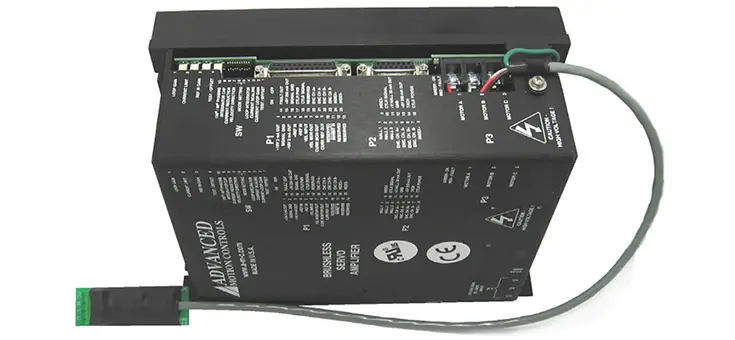Table of Contents
A servo drive is a special electronic amplifier used to power electric servomechanisms: its main task is to monitor the feedback signal from the servomechanism and continually adjusts for deviation from expected behavior. In this post, we'll try to briefly summarize what it is and how it works.
The first time we should do to properly understand such topic is to look at some servo drive basics. A servo system is made up of four components including a servo motor and drive, a controller, and a feedback device. Often, the feedback device is an encoder. The controller is programmed to instruct the motor on what it must do which then triggers the drive to send sufficient electrical energy to the motor to make the required action possible.
The controller in the system is responsible for calculating the path (trajectory) needed to send a low-voltage command signal to the drive. The drive is then responsible for sending the required voltage and current to the motor which enables it to achieve the desired motion.
A servo drive is capable of controlling the torque, velocity or position. In a servo system, the servo drive typically controls the torque.
You may also hear a servo drive being called an amplifier. It’s easy to see why as the servo drive takes the control signal from the controller to amplify it to the required voltage and current before sending it to the motor.
How Does a Servo Drive Work?
There are several types of servo drives that all serve slightly different purposes. The most common type of servo drive is a torque-mode amplifier. This servo drive converts the command signal from the controller into a specified current and sends it to the motor. The Servo drive is controlling the amount of torque that the motor can produce.
A linear servo drive works slightly differently because the current is proportional to the force rather than the torque. This directly drives the motor’s force output.
There are many types of servo drives which are classified based on their application such as the AC servo motor and DC servo motor. To distinguish between the different types of servo drives there are some considerations to be had. Is the current type AC or DC? What type of communication is being used? Does the motor use brushes? Is the motor’s rotating field synchronous or asynchronous?
AC or DC are the most basic classifications for servo drives. The main difference between the two is the ability to control speed. A DC motor is characterized by the speed being directly proportional to the supply voltage with a constant load. Whereas, an AC motor the speed is determined by the frequency of the applied voltage and the number of magnetic poles.
An AC servo motor will withstand a higher current compared to DC servo motor which is why an AC servo motor is the most commonly produced by servo drive manufactures for assembly line robotics in the manufacturing industry or any other application that requires high intensity skilled and precision work.
What is a Servo Drive Controller?
Servo drive controllers are used to control servomotors in a servo system. The controller acts as the brains. It moves information from the feedback device and sends the necessary voltage signals to the drive. The nervous system in this analogy is the drive. The drive sends the required amount of current to the motor. This is an ongoing process of reading and responding to the feedback which created a closed-loop system. This is the defining feature of a servo system allowing it to improve the transient response times, reduce any steady-state errors, and reduce the sensitivity of the system to load parameters.
A servo controller has basically two tasks to perform. The first is to track the commanded input and the second is to improve the system’s disturbance rejection. Currently, the most powerful method of control for a servo controller is proportional-integral-derivative control or PID. A PID helps to understand an error signal which is the difference between a commanded value and the actual value of an output value. This allows PID to drive the error to zero.
Where are Servo Drives Used?
Servo drives have proved useful in many industries across the globe helping companies to increase productivity and scale to sizes that were not thought possible.
Manufacturing
Servo drives are most commonly used in the manufacturing industry for assembly line robots that help to build cars and aeroplanes that require high repetition yet precise welding, drilling, fastening, sealing, dispensing, and rigid manufacturing.
Food and Pharmaceuticals
Servo drives enable better control over corrosion and better hygiene allowing high-pressure washing at high temperatures repeatedly for extended periods of time.

